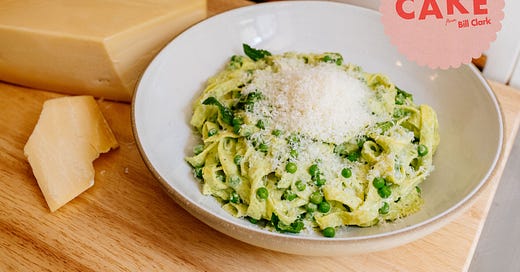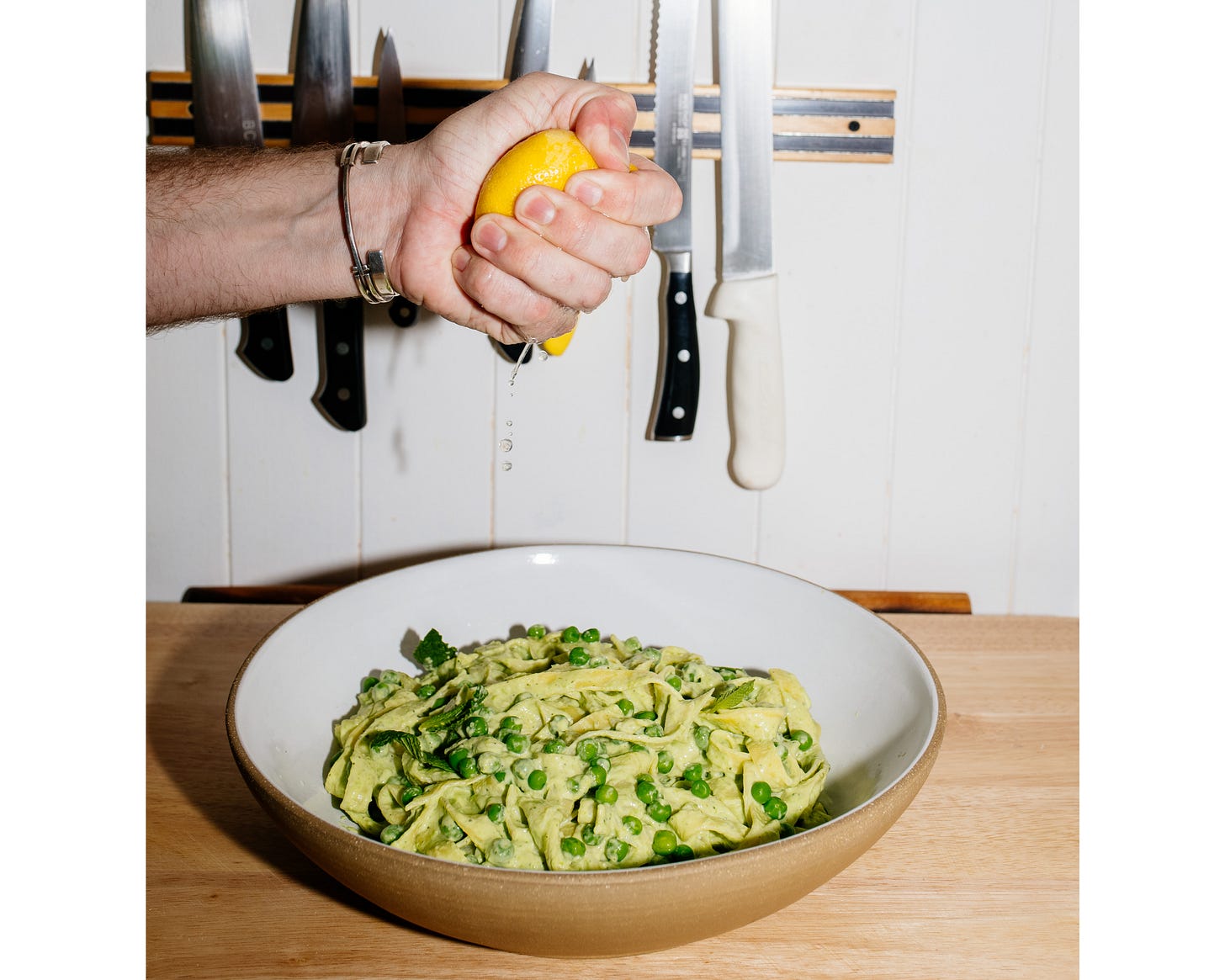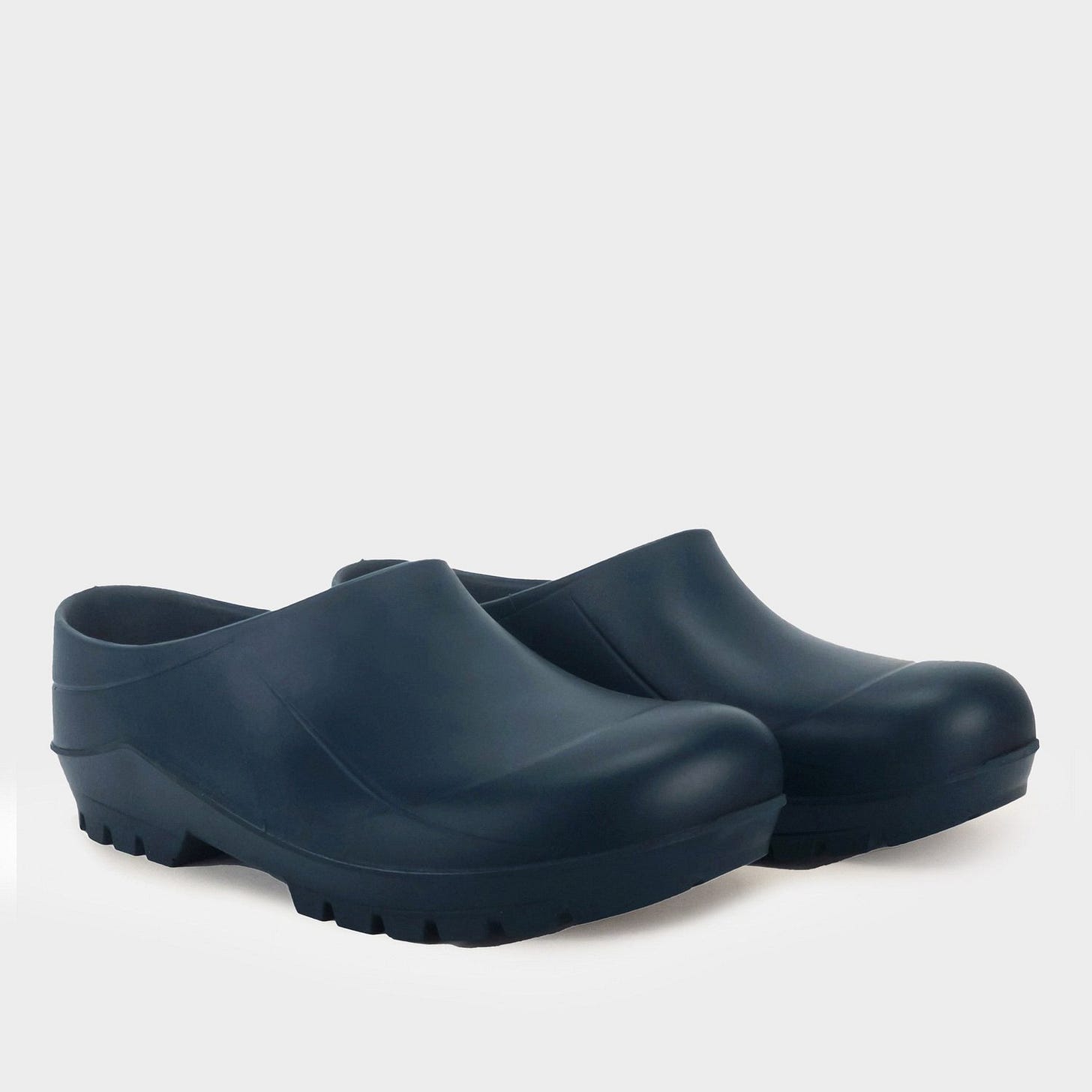It’s about time we had another quick and easy weeknight dish here on the ol’ newsletter. Now that spring has fully sprung, I find myself pretty much exclusively wanting to eat green things. Tender greens from the market, herbs from the freshly planted pots on your fire escape, and peas from the freezer (stay with me here). While it might be a little early here in the Northeast for local peas, the frozen ones are just as good, if not better.
Don’t get me wrong, a freshly-shelled English pea has its place! But that place is not the weeknight dinner table. My friend, Anna Stockwell, wrote a great piece on the superiority of frozen peas for Epicurious all the way back in 2019. She was right then and she’s right now. (By the way, you absolutely have to grab her new book, For the Table. It's a gorgeous guide to entertaining, something we all need to brush up on.) Anna covers this in her piece but I’ll give you the highlights: Frozen peas are sweeter and less starchy than their fresh counterparts, but most of all they are consistent. Consistency is nonexistent with fresh English peas. Plus, prior to being flash-frozen, the peas are steamed, so they are ready to go out of the bag. Not bad for $2.
In this recipe, you’ll drop the frozen peas into the salted boiling water, prior to the pasta, then immediately pull them out and run them under cold water. That’s it. Do not cook frozen peas to the instructions on the bag, that’s the one place where frozen peas have it wrong.
Oh, and the “two ways” in the recipe name is because you’ll toss half of the peas with the finished pasta. The second way is the pasta sauce itself: you’ll blend peas with shallots and garlic, mascarpone, mint, olive oil, and lemon. Peas two ways, and both of them are easy.
Now, I am not perfect and will readily admit to you, dear reader, my errors. I tested this recipe with dried pasta, and it was great. But then when it came time shoot with Hunter, I was feeling fancy and grabbed some fresh pasta. Do not be like me. The fresh pasta quickly became gummy and did not hold up under the sauce. Learn something from this! You’ll have a much glossier finished dish if you use dried pasta.
Additionally, this pasta should be assembled and served immediately. A splash of pasta water and a drizzle of good olive oil will help carry you to the table. But just like all the best parts of spring: this pasta won’t last long.
Peas Two-Way Pasta
2 shallots, thinly sliced
2 cloves garlic, thinly sliced
3 tablespoons olive oil, divided
1 bag frozen peas
1 cup mascarpone
¼ cup packed mint leaves
1 teaspoon Diamond Crystal kosher salt
Lemon juice to taste
1.5 lbs dried pasta of choice
Place 4 quarts of well-salted water on to boil.
In a skillet over medium heat, drizzle a tablespoon of olive oil. Add the sliced shallot and garlic. Cook until translucent and fragrant. Season with black pepper. Remove from heat and set aside.
Once the water has come to a boil, dump the entire bag of frozen peas in the pot. Give a few stirs and remove the peas using a spider or wire mesh sieve. Run them under cold water and set aside. Bring the pot of water back to a boil.
In a blender, place the cooked shallots and garlic, half the cooked peas, the mascarpone, the mint, salt, and 2 tablespoons of olive oil. Blend until smooth, season with pepper and lemon to taste.
Cook the pasta al dente and remove from the water. Reserve 2 cups of the pasta water. Toss the pasta with the pea sauce and the remaining half of cooked peas. Add pasta water in small splashes until the pasta is glossy and saucy. Serve with a squeeze of lemon, torn mint leaves, and a drizzle of good olive oil.
Quick Bites
After a long time of crushing from afar, I finally got to eat at Middle Child Clubhouse last weekend. TBH we went to go snag some of their merch but it was sold out by the time we got there. But still, we enjoyed everything (but especially that babka French toast). Plus, everyone who worked there was extremely sweet. It’s just such a pleasure to be in a place that knows what they’re doing.
I’ve been deep in gardening mode the last couple of weeks, which means I’ve also been deep in garden-gear browsing. I’m crushing on these Gardenheir Italian Garden Clogs, and am currently locked in a battle with Andrew over who gets to own them. At $68, maybe we both can: but we’re absolutely not allowed to wear them on the same day.
Speaking of crushes, I am so ready to go to Cafe Spaghetti. I think the name says it all.
A Piece of Cake is written by Bill Clark and edited by Andrew Spena. Photography by Hunter Abrams. Logo design by Brett LaBauve.













